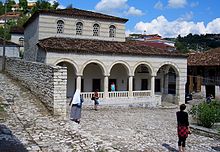Khanqah
![]()
The title of this article is ambiguous. For other meanings, see Tekke (disambiguation).
A tekke (Ottoman تكيه tekye; Bosnian tekija; Albanian teqe; Arabic زاوية zāwiya; Persian درگاه dargāh or خانقاه chāneqāh, from the latter also transcribed khanqah, khaniqah or khanqa; pl. the tekken) is a center of a Sufi brotherhood (dervish order, or tariqa) and means "retreat", "shelter", or "asylum". It is less common to speak of a convent, for one cannot compare a tekke with the Christian notion of a monastery.
There are mainly dhikr ceremonies, where dervishes invoke God with his most beautiful names. But the place can also serve for study or other work.

Halveti Tekke in Albanian Berat
Origin
The age of the Islamic prophet Muhammad is considered by Muslims to be the "golden age of Islam", in which Muslims of that time would have lived in accordance with the laws of the religion, which was still so young. This situation changed, however, fairly soon after the Prophet's death, when Islam was spread through campaigns of conquest in North Africa and Asia. Islam then suffered the fate of many a religion and increasingly became lip service among the general population.
In protest against this situation, the Sufis began to lead an ascetic lifestyle. There are scattered reports of Muslim ascetics from the time of Muhammad, but it was not until decades, if not centuries, after Muhammad's death that the Sufis began to organize themselves into larger and larger orders. At that time, they met in larger houses or simply outdoors in the countryside to worship together. However, since these places were not protected against outside disturbance, the first tekken gradually emerged.
The foundation of the first tekke, according to popular opinion, took place in 150 H / 767 AD in Damascus. Further foundations followed in Iraq and Khorasan, before they became established throughout the Islamic world.
Various types of Tekken
In different cultural areas Tekken have different names and sometimes slightly different functions.
In the eastern Islamic region as well as in medieval Egypt, the places of assembly are called chānegāh. There they were cultural as well as theological centers and were usually supported by the government. In other cases, they consisted of foundations and were maintained by influential benefactors.
The term zāwiya literally means "angle". This type of meeting place is more commonly used for smaller buildings, and is also the name given to the dwelling of the sheikh, the head of a tekke or order, where the dervishes meet for dhikr. In addition, in earlier times they were often located at crossroads of major travel routes and thus served as resting places for the wandering dervishes. The Turks call the Sufi centers tekke or dargāh (Persian), the latter meaning "doorstep" or "something that is between two places."
Search within the encyclopedia